A) A
B) B
C) C
D) D
Correct Answer

verified
Correct Answer
verified
True/False
A monopolist will avoid setting a price in the elastic segment of the demand curve and prefer to set the price in the inelastic segment.
Correct Answer

verified
Correct Answer
verified
Multiple Choice
 Refer to the data for a nondiscriminating monopolist. At its profit-maximizing output, this firm's total profit will be
Refer to the data for a nondiscriminating monopolist. At its profit-maximizing output, this firm's total profit will be
A) $82.
B) zero.
C) $54.
D) $27.
Correct Answer

verified
Correct Answer
verified
Multiple Choice
Which of the following is not a possible source of natural monopoly?
A) large-scale network effects
B) simultaneous consumption
C) greater use of specialized inputs
D) rent-seeking behavior
Correct Answer

verified
Correct Answer
verified
Multiple Choice
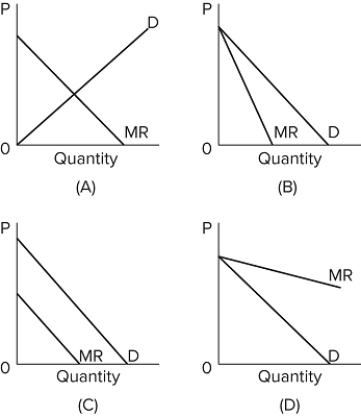 Which of the graphs shows the correct relationship between demand and marginal revenue?
Which of the graphs shows the correct relationship between demand and marginal revenue?
A) A
B) B
C) C
D) D
Correct Answer

verified
Correct Answer
verified
Multiple Choice
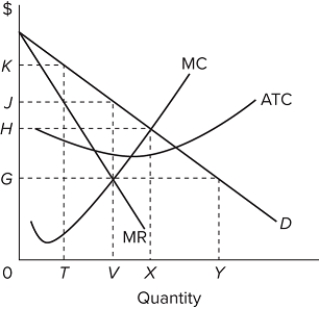 Refer to the graph for a profit-maximizing monopolist. The firm will produce a quantity equal to the distance:
Refer to the graph for a profit-maximizing monopolist. The firm will produce a quantity equal to the distance:
A) 0 V.
B) 0 Y.
C) 0 T.
D) 0 X.
Correct Answer

verified
Correct Answer
verified
Multiple Choice
The ability of personalized pricing by online retailers to price discriminate
A) is enhanced by Big Data's ability to accurately determine a buyer's reservation price.
B) is only effective at the group level.
C) means that buyers with more elastic demand face systematically higher prices.
D) is limited by buyers' willingness and ability to easily search out lower prices at other online sites.
Correct Answer

verified
Correct Answer
verified
Multiple Choice
A monopolist can sell 10 toys per day for $10.00 each. To sell 11 toys per day, the price must be cut to $9.50. The marginal revenue of the 11th toy is
A) $9.50.
B) $-0.50.
C) $4.50 .
D) $11.
Correct Answer

verified
Correct Answer
verified
Multiple Choice
If a regulatory commission wants to establish a socially optimal price for a natural monopoly, it should select a price
A) at which the marginal cost curve intersects the demand curve.
B) at which marginal revenue is zero.
C) at which the average total cost curve intersects the demand curve.
D) that corresponds with the equality of marginal cost and marginal revenue.
Correct Answer

verified
Correct Answer
verified
Multiple Choice
If a pure monopolist can price discriminate by separating buyers into two or more groups,
A) the marginal revenue curve and the total revenue curve will now coincide.
B) the marginal revenue curve will now shift to a position above the demand curve.
C) the firm will face multiple marginal revenue curves.
D) marginal revenue will become less at each level of output than it would be without price discrimination.
Correct Answer

verified
Correct Answer
verified
Multiple Choice
Which of the following is a characteristic of pure monopoly?
A) close substitute products
B) barriers to entry
C) the absence of market power
D) "price taking"
Correct Answer

verified
Correct Answer
verified
True/False
If a monopolist finds itself operating in the inelastic portion of its demand curve, then it should never lower its price because doing so would reduce its profits.
Correct Answer

verified
Correct Answer
verified
Multiple Choice
Marginal costs of a producer may be very small due to its product's ability to satisfy a large number of consumers at the same time. This characteristic of a product is called
A) economies of scale.
B) rent-seeking.
C) simultaneous consumption.
D) consumer sovereignty.
Correct Answer

verified
Correct Answer
verified
Multiple Choice
Which is true of a price-discriminating pure monopolist?
A) P > MR for the last unit sold.
B) Profit will be higher than in the nondiscriminating case.
C) The average price will be higher than in the nondiscriminating case.
D) Allocative inefficiency will be greater than in the nondiscriminating case.
Correct Answer

verified
Correct Answer
verified
Multiple Choice
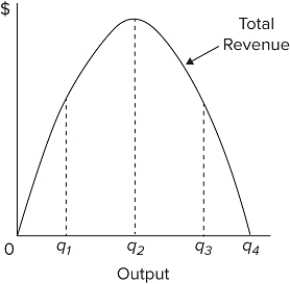 Refer to the diagram for a nondiscriminating monopolist. The profit-seeking monopolist will
Refer to the diagram for a nondiscriminating monopolist. The profit-seeking monopolist will
A) always produce at output q₂.
B) always produce more than q₂.
C) never produce an output larger than q₂.
D) never produce an output larger than q₁.
Correct Answer

verified
Correct Answer
verified
Multiple Choice
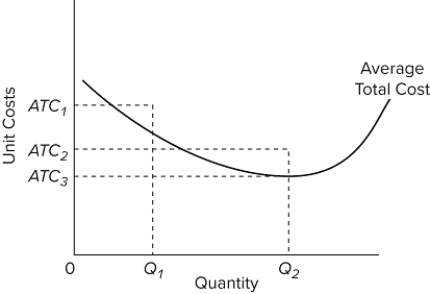 Refer to the long-run cost diagram for a firm. If the firm produces output Q₂ at an average cost of ATC₃, then the firm is
Refer to the long-run cost diagram for a firm. If the firm produces output Q₂ at an average cost of ATC₃, then the firm is
A) producing the profit-maximizing output but is failing to minimize production costs.
B) incurring X-inefficiency but is realizing all existing economies of scale.
C) incurring X-inefficiency and is failing to realize all existing economies of scale.
D) producing that output with the most efficient combination of inputs and is realizing all existing economies of scale.
Correct Answer

verified
Correct Answer
verified
Multiple Choice
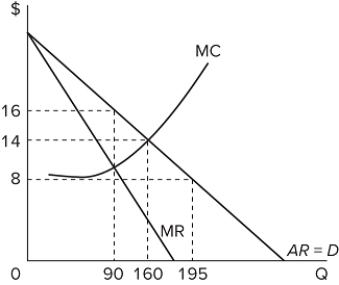 If the industry depicted in this graph were purely competitive, the output quantity would be
If the industry depicted in this graph were purely competitive, the output quantity would be
A) 90.
B) 160.
C) 195.
D) a level that is not labeled in the graph.
Correct Answer

verified
Correct Answer
verified
True/False
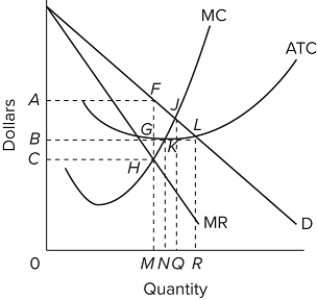 Refer to the diagram for a nondiscriminating monopolist. The profit-maximizing output for this firm is M.
Refer to the diagram for a nondiscriminating monopolist. The profit-maximizing output for this firm is M.
Correct Answer

verified
Correct Answer
verified
True/False
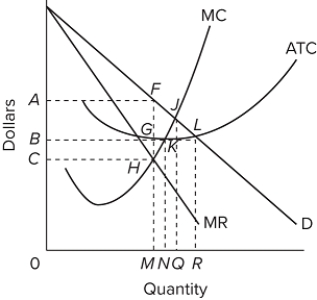 Refer to the diagram for a nondiscriminating monopolist. At output R economic profits will be zero.
Refer to the diagram for a nondiscriminating monopolist. At output R economic profits will be zero.
Correct Answer

verified
Correct Answer
verified
Multiple Choice
The supply curve for a monopoly is
A) the portion of the marginal cost curve that lies above the average variable cost curve.
B) the portion of the marginal cost curve that lies above the average total cost curve.
C) the portion of the marginal cost curve that lies above the average fixed cost curve.
D) not clearly defined.
Correct Answer

verified
Correct Answer
verified
Showing 261 - 280 of 407
Related Exams